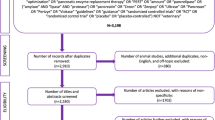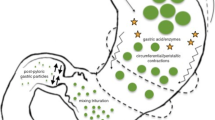Abstract
Secretin is used in the United States for diagnosis of pancreatic gastrointestinal (GI) dysfunction and disease. Repeated therapeutic use has not been approved. Widespread interest in secretin as a treatment for autism followed media reports of behavioral improvements in an autistic child who received the hormone during a GI diagnostic procedure. International demand for secretin soared in the absence of experimental evidence of its efficacy for autism. This review presents a brief history of secretin's rise to popularity and summarizes research on secretin as a treatment for autism. Seventeen studies are reviewed comparing the effects of secretin forms, dosage levels, and dosing intervals on outcome measures with approximately 600 children. Twelve of 13 placebo-controlled studies failed to demonstrate the differential efficacy of secretin. Implications for advocating treatment in the absence of empirical evidence are discussed.
Similar content being viewed by others
REFERENCES
Alexander, D. (1999, December). Study shows secretin fails to bene t children with autism [Comments ]. NIH News Alert, National Institutes of Health.
Aman, M. G., & Armstrong, S. A. (2000). Regarding secretin for treating autistic disorder [Letter to the editor ]. Journal of Autism and Developmental Disorders, 30, 71–72.
American Academy of Child & Adolescent Psychiatry. (1999, March 3). Secretin in the treatment of autism. [Policy state-ment ]. Retrieved June 26, 2002, from http://www. aacap. org/ publications/policy/ps30.htm#TOP.
American Psychiatric Association. (1994). Diagnostic and statisti-cal manual of mental disorders (4th ed.). Washington, DC: Author.
Banks, W. A., Goulet, M., Rusche, J. R., Nieho., M. L., & Boismenu, R. (2002). Differential transport of a secretin ana-log across the blood-brain and blood-cerebrospinal. uid barriers of the mouse. The Journal of Pharmacology and Experimental Therapeutics, 302, 1062–1069.
Bertrand, J., Mars, A., Boyle, C., Bove, F., Yeargin-Allsopp, M., & Decoufle, P. (2001). Prevalence of autism in a United States population:The Brick Township, New Jersey, investi-gation. Pediatrics, 108, 1155–1161.
Black, C., Kaye, J. A., & Jick, H. (2002). Relation of childhood gastrointestinal disorders to autism:Nested case-control study using data from the UK General Practice Research Database. British Medical Journal, 325, 419–421.
Carey, T., Ratliff-Schaub, K., Funk, J., Weinle, C., Myers, M., & Jenks, J. (2002). Double-blind placebo-controlled trial of secretin:Effects on aberrant behavior in children with aut-ism. Journal of Autism and Developmental Disorders, 32, 161–167.
Chez, M. G., & Buchanan, C. P. (2000). Reply to B. Rimland's “comments on ‘secret in and autism:A two-part clinical investigation.’ ”Journal of Autism and Developmental Disor-ders, 30, 97.
Chez, M. G., Buchanan, C. P., Bagan, B. T., Hammer, M. S., McCarthy, K. S., Ovrutskaya, I., et al. (2000). Secretin and autism:A two-part clinical investigation. Journal of Autism and Developmental Disorders, 30, 87–94.
Christ, A., Werth, B., Hildebrand, P., Gyr, K., Stalder, G. A., & Beglinger, C. (1988). Human secretin:Biologic effects and plasma kinetics in humans. Gastroenterology, 94, 311–316.
Coniglio, S., Lewis, J. D., Lang, C., Burns, T. G., Subhani-Siddique, R., Weintraub, A., et al. (2001). A randomized, double-blind, placebo-controlled trial of single-dose intravenous secretin as treatment for children with autism. The Journal of Pediatrics, 138, 649–655.
Connors, S. L., & Crowell, D. E. (1999). Secretin and autism: The role of cysteine [Letter to the editor ]. Journal of the American Academy of Child and Adolescent Psychiatry, 38, 795–796.
Corbett, B., Khan, K., Czapansky-Beilman, D., Brady, N., Dropik, P., Zelinsky Goldman, D., et al. (2001). A double-blind, placebo-controlled crossover study investigating the e. ect of porcine secretin in children with autism. Clinical Pediatrics, 40, 327–331.
DiCicco-Bloom, E. (1998). Invited commentary. Newsletter of the National Alliance for Autism Research, 4, 24.
Dunn-Geier, J., Ho, H. H., Auersperg, E., Doyle, D., Eaves, L., Matsuba, C., et al. (2000). Effect of secretin on children with autism:A randomized controlled trial. Developmental Medi-cine and Child Neurology, 42, 796–802.
Fombonne, E., & Chakrabarti, S. (2001). No evidence for a new variant of measles-mumps-rubella-induced autism. Pediatrics, 108, Article e58. Retrieved August 18, 2003, from http:// www. pediatrics. org/cgi/content/full/108/4/e58.
Hardman, M. L., Drew, C. J., & Egan, M. W. (1999). Human exceptionality:Society, school, and family (6th ed.). Boston: Allyn and Bacon.
Herbert, J. D., Sharp, I. R., & Gaudiano, B. A. (2002). Separat-ing fact from ction in the etiology and treatment of autism: A scientific review of the evidence. The Scientific Review of Mental Health Practice, 1, 23–43. Retrieved December 9, 2002, from http://www. scienti cmentalhealth. org/SRMHP/ current. html.
Hirsch, D. (1999). Secretin in the treatment of autism. The Exceptional Parent, 29, 94.
Horvath, K. (2000). Secretin treatment for autism [Letter to the editor ]. The New England Journal of Medicine, 342, 1216.
Horvath, K., Papadimitriou, J. C., Rabsztyn, A., Drachenberg, C., & Tildon, J. T. (1999). Gastrointestinal abnormalities in chil-dren with autistic disorder. Journal of Pediatrics, 135, 559–563.
Horvath, K., & Perman, J. A. (2002). Autism and gastrointestinal symptoms. Current Gastroenterology Reports, 4, 251–258.
Horvath, K., Stefanatos, G., Sokolski, K. N., Watchel, R., Nabors, L., & Tildon, J. T. (1998). Improved social and lan-guage skills after secretin administration in patients with autistic spectrum disorders. Journal of the Association for Academic Minority Physicians, 9, 9–15.
Kern, J. K., Miller, V. S., Evans, P. A., & Trivedi, M. H. (2002). Efficacy of porcine secretin in children with autism and per-vasive developmental disorder. Journal of Autism and Devel-opmental Disorders, 32, 153–160.
Lightdale, J. R., Hayer, C., Duer, A., Lind-White, C., Jenkins, S., Siegel, B., et al. (2001, November). Effects of intravenous secretin on language and behavior of children with autism and gastrointestinal symptoms:A single-blinded, open-label pilot study. Pediatrics, 108, Article e90. Retrieved June 11, 2002, from http://www. pediatrics. org/cgi/content/full/108/5/e90.
McMillin, D. L., Richards, D. G., Mein, E. A., & Nelson, C. D. (1999). The abdominal brain and enteric nervous system. The Journal of Alternative and Complementary Medicine, 5, 575–586.
McQueen, J. M., & Heck, A. M. (2002). Secretin for the treatment of autism. The Annals of Pharmacotherapy, 36, 305–311.
Mesibov, G., Schopler, E., Schaffer, B., & Michal, N. (1989). Use of the Childhood Autism Rating Scale with autistic adoles-cents and adults. Journal of the American Academy of Child and Adolescent Psychiatry, 28, 538–541.
Molloy, C. A., Manning-Courtney, P., Swayne, S., Bean, J., Brown, J. M., Murray, D. S., et al. (2002). Lack of benefit of intravenous synthetic human secretin in the treatment of autism. Journal of Autism and Developmental Disorders, 32, 545–551.
National Institute of Child Health and Human Development. (1999, December 8). [National Institutes of Health News Alert ]. Study shows secretin fails to bene t children with aut-ism. Retrieved June 10, 2002, from http://www. nichd. nih.-gov/new/releases/secretin1299.htm.
Owley, T., McMahon, W., & Cook, E. H. (2001). Multisite, dou-ble-blind, placebo-controlled trial of porcine secretin in aut-ism. Journal of the American Academy of Child and Adolescent Psychiatry, 40, 1293–1299.
Owley, T., Steele, E., Corsello, C., Risi, S., McKaig, K., Lord, C., et al. (1999, October 6). A double-blind, placebo-controlled trial of secretin for the treatment of autistic disor-der. Medscape General Medicine, 1, 1–8. Retrieved June 12, 2002, from http://medscape. com/viewarticle/408013.
Rimland, B. (1999, January). The use of secretin in autism:some preliminary answers. Autism Research Review International. Retrieved June 1, 2002, from http://www. autism. com/ari/ newslet. html.
Rimland, B. (2000). Comments on “Secretin and autism:A two-part clinical investigation” by M. G. Chez et al. Journal of Autism and Developmental Disorders, 30, 95.
Roberts, W., Weaver, L., Brian, J., Bryson, S., Emelianova, S., Griffths, A.-M., et al. (2001, May). Repeated doses of por-cine secretin in the treatment of autism:A randomized, pla-cebo-controlled trial. Pediatrics, 107, Article e71. Retrieved June 11, 2002, from http://www. pediatrics. org/cgi/content/ full/107/5/e71.
Robinson, T. W. (2001). Homeopathic secretin in autism:A clini-cal pilot study. British Homeopathic Journal, 90, 86–91.
Sandler, A. D., & Bodfish, J. W. (2000). Placebo effects in aut-ism:Lessons from secretin. Developmental and Behavioral Pediatrics, 21, 347–350.
Sandler, A. D., Sutton, K. A., DeWeese, J., Girardi, M. A., Sheppard, V., & Bodfish, J. W. (1999). Lack of bene t of a single dose of synthetic human secretin in the treatment of autism and pervasive developmental disorder. New England Journal of Medicine, 341, 1801–1806.
Shutt, C. E. (1998). Secretin and autism:A clue but not a cure. Newsletter of the National Alliance for Autism Research, 4, 21–24.
Smith, T. (1999). Outcome of early intervention for children with autism. Clinical Psychology:Science and Practice, 6, 33–49.
Sponheim, E., Oftedal, G., & Helverschou, S. B. (2002). Multiple doses of secretin in the treatment of autism:A controlled study. Acta Pædiatrica, 91, 540–545.
Tanguay, P. E. (2002). Commentary:The primacy of the scien-tific method. Journal of the American Academy of Child and Adolescent Psychiatry, 41, 1322–1323.
Taylor, B., Miller, E., Lingam, R., Andrews, N., Simmons, A., & Stowe, J. (2002). Measles, mumps, and rubella vaccination and bowel problems or developmental regression in children with autism:population-based study. British Medical Jour-nal, 324, 393–396.
Unis, A. S., Munson, J. A., Rogers, S. J., Goldson, E., Osterling, J., Gabriels, R., et al. (2002). A randomized, dou-ble-blind, placebo-controlled trial of porcine versus synthetic secretin for reducing symptoms of autism. Journal of the American Academy of Child and Adolescent Psychiatry, 41, 1315–1321.
Veenstra-Vanderweele, J., & Cook, E. H., Jr. (2003). Genetics of childhood disorders:XLVI. Autism, part 5:Genetics of aut-ism. Journal of the American Academy of Child and Adoles-cent Psychiatry, 42, 116–118.
Volkmar, F. (1999). Lessons from secretin [Commentary ]. The New England Journal of Medicine, 341, 1842–1844.
Volkmar, F. (2000). [Letter to the editor ]. The New England Jour-nal of Medicine, 342, 1218.
Yung, W.-H., Leung, P.-S., Ng, S. S. M., Zhang, J., Chan, S. C. Y., & Chow, B. K. C. (2001). Secretin facilitates GABA trans-mission in the cerebellum. The Journal of Neuroscience, 21, 7063–7068.




